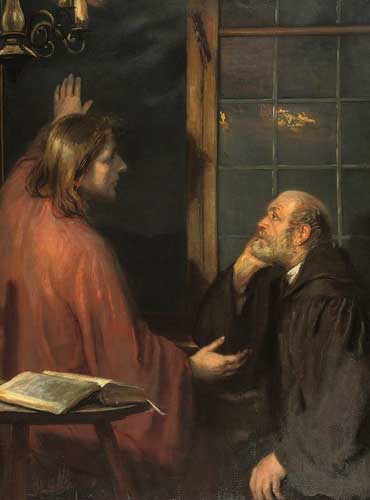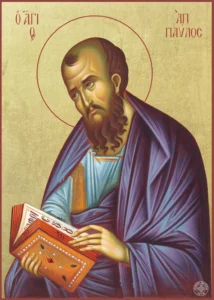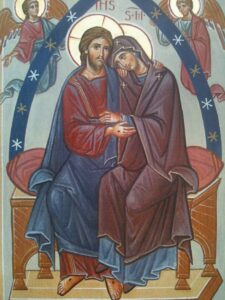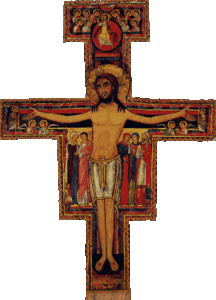Tuesday of the Second Week of Easter – Option 2 – Jn 3:7b-15
Today, as we make our way through the second week of Easter, the Church asks us to meditate on the encounter between Nicodemus and Christ. Today’s Gospel repeats the last part of yesterday’s Gospel, regarding the wind, and then continues the discussion with a beautiful reference to Christ’s passion, where Jesus tells Nicodemus: “Just as Moses lifted up the serpent in the desert, so must the Son of Man be lifted up, so that everyone who believes in him may have eternal life.”
Jesus is referring to what Fulton Sheen called “the most famous foreshadowing of the Cross in the Old Testament,” an incident recounted in chapter 21 of the Book of Numbers. There, we read that the Israelites complained time and time against Moses, and, as a punishment, venomous snakes were allowed to come among the people, biting many and killing a number of them. But God, in His mercy, gave Moses a solution: he was to make a snake out of bronze and mount it on a wooden pole. Anyone who looked on it, the Lord said, would be healed. The result? “As many as looked upon it were healed.” Notice, though, that the Bible doesn’t say that all of them looked at it; we can assume that some of the bitten people refused to look at it, and they died as a result. Think of how ridiculous this is: God gave them the way to be saved, to be healed, and they refused it. They had the key to saving their earthly lives right there, in front of them! Moses told them everything they needed to do, and it was simple. Yet, they refused.
Jesus applies this symbol to Himself: Jesus says He will be lifted up, just like the bronze serpent. In this, as Fulton Sheen notices, “The meaning now became clear: the bronze serpent in the desert looked like the serpent that bit the people; but though it seemed to be the same, it was actually without any poison. Our Blessed Lord now says that He is like that bronze serpent. He, too, would be lifted up on a tree, a Cross. He would look as if He Himself was filled with the poison of sin, since His Body would bear the marks of sin; and yet as the brass serpent was without poison so He would be without sin. As those who looked upon that brass serpent in the desert in faith were healed from the serpent’s bite, so all who would look upon Him on His Cross bearing the sins and poisons of the world would also be healed of the poison of the serpent, Satan.” This is the measure of God’s love: just as He gave Moses the remedy for physical death, He gives each and every one of us the remedy for spiritual death in His Son, raised on the wood of the Cross. This leads to our second point, the wideness of God’s mercy.
Looking at the serpent healed only one, particular, physical evil. However, Christ on the cross heals the worst evil of all, that of sin, and He heals it in its many forms and great varieties. It’s no wonder that many of the doctors of the Church called Christ “the Divine Physician!” And, just as we need doctors because there are illnesses in the world, “it is precisely because sin exists in the world” that God gave His only Son. However, this salvation is His free gift to us, like the bronze snake in the desert. The Israelites, let us remember, had abandoned God; they were complaining and refused to listen to the man God had appointed to lead them. God could have just let them die in the desert, but He didn’t; He saved them. So now with us: after original sin, not to mention all our personal sins, God could have left us alone. He could have abandoned us, but He didn’t and He doesn’t. He sends His only-begotten Son.
In His response to Nicodemus, Jesus alludes to the fact that some people will refuse to believe in Him, and thus they will be condemned. It’s not uncommon to be asked by well-meaning people: “Have you accepted the Lord Jesus as your personal Lord and savior?” or “Do you believe in Jesus Christ?” If these people know that we’re Catholics, often they don’t expect that we’ll say “Yes!” But, we can, and rightly, tell them yes. However, we, in turn, can point out that simply “believing in” Jesus in some abstract sense won’t get us to heaven. Saint Paul says it clearly in his letter to Titus: there are people who “claim to know God, but by their deeds they deny him” (1:16). For a time, the saying “Jesus saves” was a popular slogan. The question, though, is how? God is merciful, and, as Saint Peter writes, He doesn’t want anyone to perish. However, we have to make use of the means He gives us, the way He wants us to be saved: He clearly tells us that His Church is built on Peter, and His Church remains the depositary and interpreter of the entire moral law, with the means, such as the sacraments, to bring us back to God. God gives us His Son so that we might be saved, just as He gave the Israelites the bronze serpent. The solution was simple, and yet many still perished. Today, we have all the means, everything we need, to reach heaven. We just need to have faith in Him, and, with and through our faith, to do what He asks of us: “In this way,” writes Saint John in his first letter, “we know that we love the children of God when we love God and obey his commandments. For the love of God is this, that we keep his commandments. And his commandments are not burdensome.”
As we continue our Easter celebration, let us pray, through the intercession of Our Lady, Refuge of Sinners, for the grace to respond to God’s love with generosity, and so avoid being like those who looked upon the cross and were not saved.






